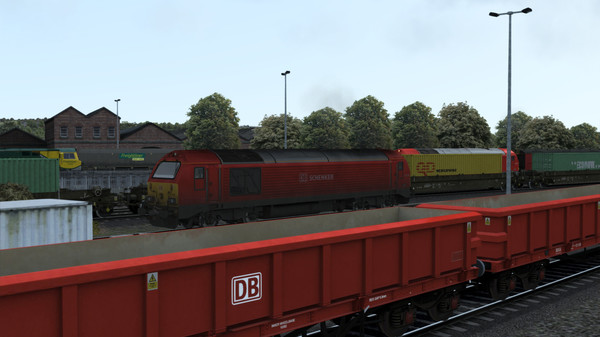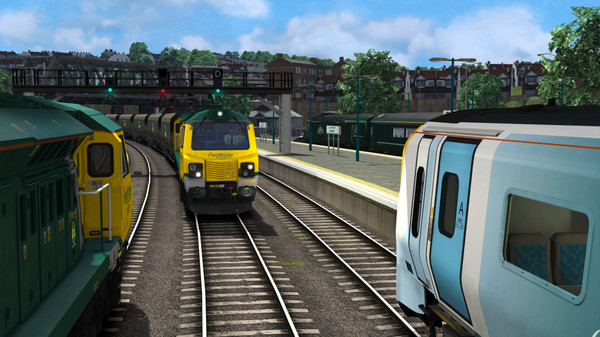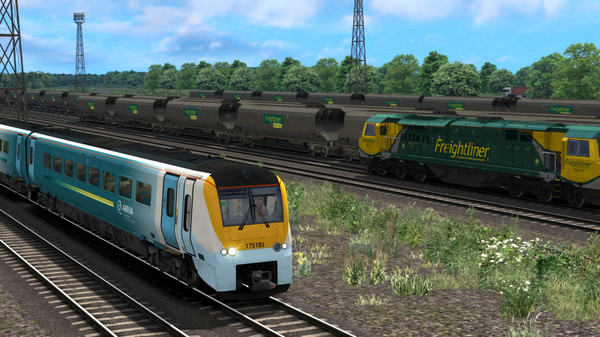Trong trường hợp sản phẩm hết hàng, bạn vui lòng tham khảo sản phẩm steam wallet hoặc liên hệ fanpage để được tư vấn thêm.
Directly connecting England and Wales, running under the longest river in the United Kingdom, the South Wales Main Line is one of the most important cross border routes in the country, as featured in the beautiful new Extended South Wales Coastal route for Train Simulator.Isambard Kingdom Brunel was rapidly expanding the Great Western Railway out of London Paddington. By June 1841, the line to Bristol had officially opened and set in stone was a railway line that has proven vital to the west throughout the years. To extend the usage of this revolutionary line, an extension was built out from Swindon and headed north towards Gloucester, only to then turn tail, breach South Wales and head for Swansea via Caldicot, Newport, Cardiff and Bridgend.
The new line to Swansea opened in 1850 and provided Wales with a much needed, albeit quite lengthy connection with London and other major towns along the Great Western Main Line such as Reading, Didcot, Swindon and Bristol. Until 1872, the railway was built utilising Brunel’s 7ft broad gauge, as was the entire GWR network. However, despite the potential benefits of this larger gauge over standard gauge, the latter was already gaining momentum as the primary choice for all railways and Swansea through to the west of England was rapidly converted.
A breakthrough for the residents of South Wales occurred in 1886 when the 4 mile, 624 yard-long Severn Tunnel finished completion after a difficult 13 year construction phase. The new tunnel was the longest in the UK, a record it held for over a century, only being superseded by the High Speed 1 tunnels surrounding Stratford in 2007. The tunnel allowed for a new route into South Wales which would bypass the line via Gloucester, massively decreasing journey times beyond no doubt. Following the opening of the new path under the Severn, the former Gloucester route became known as the ‘Great Way Round’.
The construction of the tunnel came with many struggles, thanks to a vast pool of water, separate to the Severn River, workers who were cutting away under the terrain were faced with multiple, and occasionally severe flooding. Having water pour into the bore of the tunnel on a constant basis was naturally a concern, so pumps were installed to move water away from the tunnel wall exterior in an effort to prevent major incidents.
Severn Tunnel Junction station opened as part of the new route, along with an extensive marshalling yard which would be used to easily distribute Welsh coal to London and the Midlands. Many of the heavy freight services in the steam era were not able to navigate the Severn Tunnel without a pilot or banker locomotive, as the steep gradients could easily bring a heavy service to a halt or cause almost uncontrollable acceleration. In the later years of British Railways, ex. GWR 5101 Class locos were used for this purpose.
With routes running to Bristol, Manchester and Gloucester, the line between Cardiff and Severn Tunnel Junction is 4 tracks wide to ease any potential congestion between the mix of express and local passenger services. With all the passenger services, and also the sheer volume of freight traction which is seen along the line, the tunnel itself has seen upwards of 200 trains run through it daily. In comparison, the railway beyond Cardiff and onto Swansea is only twin-tracked, providing a much more rural feel for the final stretch across South Wales.
Nowadays, the tunnel is accompanied by the M4 Motorway Bridge which connects London to Wales. The bridge, alongside the closure of much of the Welsh coal industry, has seen some decline in rail freight traffic however there are still industries keeping freight alive on the rails. Port Talbot, home to one of the largest steelworks in Europe, sees constant traffic out of its extensive railway yards and sidings, with steel trains travelling the breadth of the country. Back at Severn, the motorway bridge is carefully designed so to avoid putting any weight over the tunnel, as the increased pressure load on the walls could lead to flooding and collapse.
Today the line sees operations from Great Western Railway which mainly provide express services from London into Cardiff and Swansea with Arriva Trains Wales running both local and longer-distance journeys throughout Wales and beyond. One local service in particular, named Swanline, is an every-other-hour timetabled service that operates between Swansea and Cardiff Central. Swanline was introduced in in 1994 to coincide with 5 additional stations which had recently opened on the main line; Llansamlet, Skewen, Briton Ferry, Baglan and Pyle and was initially an hourly service formed of doubled up multiple units. In recent years, proposals have been assessed which aim to increase connections in the Swansea Bay area by cutting journeys off at Port Talbot, before returning to Swansea. Any resolution is yet to be brought into fruition.
The Great Western Main Line, and of course the South Wales Main Line, are currently undergoing a major redevelopment to ensure that the Greater West is well suited for the future. As decades have gone by, many of Britain’s key routes have been electrified to allow for higher speeds, cleaner trains, for both the environment and the passengers, and more comfortable journeys. The west coast, the east coast, the south coast, all these railways were fully fitted with electric capability by the end of the 20th Century. The Great Western Railway network however, despite being one of the busiest commuter corridors in the country, had managed to avoid the wires.
The South Wales Coastal – Bristol to Swansea route for Train Simulator recreates the 85 mile section of main line from Bristol Temple Meads and Bristol Parkway to Swansea, via the Severn Tunnel. Also included are a large selection of locomotives and freight wagons to replicate services on the line as seen today, including the Arriva Trains Wales Class 175 ‘Coradia’ DMU, Freightliner Class 70, DB Schenker Class 67 and Great Western Railways Class 43 HST.
Included Locomotives & Rolling Stock
- BR Class 175 in Arriva Trains Wales ‘Ghost’ Livery
- BR Class 175 in Arriva Trains Wales Livery
- BR Class 67 in DB Schenker Livery
- BR Class 70 in Freightliner Livery
- BR Class 43 in Great Western Railways Livery
- BYA Bogie Steel Coil Wagon in DB Schenker Livery
- MXA Bogie Ballast Wagon in DB Schenker Livery
- BR Mk1 BG Mail Vehicle in RES Livery
- BR Mk1 GUV Parcels Vehicle in RES Livery
- HHA Bogie Coal Hopper Wagon in Freightliner Livery
- FEA/B Bogie Container Wagons in Generic Livery
- KTA Pocket Container Wagon in Generic Livery
Included Scenarios
The South Wales Coastal: Bristol - Swansea Route Add-on includes ten challenging career scenarios:- Pt 1: 1V40 Manchester Piccadilly to Carmarthen
- Pt 2: 1V40 Manchester Piccadilly to Carmarthen
- 1W48 Carmarthen to Manchester Piccadilly
- 1B41 Milford Haven to Cardiff Central
- Pt 1: 6H23 Margam T.C. to Llanwern Exchange Sdgs
- Pt 2: 6H23 Margam T.C. to Llanwern Exchange Sdgs
- 6V05 Round Oak to Margam T.C.
- 1V05 – 1803 Nottingham to Swansea
- 1M77 – 1905 Cardiff Central to Swindon
- 1M91 – 1630 Bristol Temple Meads to Crewe
More scenarios are available on Steam Workshop online and in-game. Train Simulator’s Steam Workshop scenarios are free and easy to download, adding many more hours of gameplay. With scenarios being added daily, why don’t you check it out now!
Click here for Steam Workshop scenarios.
Key Features
- 85 mile South Wales Main Line between Bristol Temple Meads and Bristol Parkway to Swansea, via the Severn Tunnel
- Four trains for you to experience including the classic BR Class 175 and BR Class 70
- Selection of Mail and Freight rolling stock
- Ten challenging Career Scenarios
- Railfan Mode Scenarios
- Quick Drive compatible
- Download size: 286.5 mb















